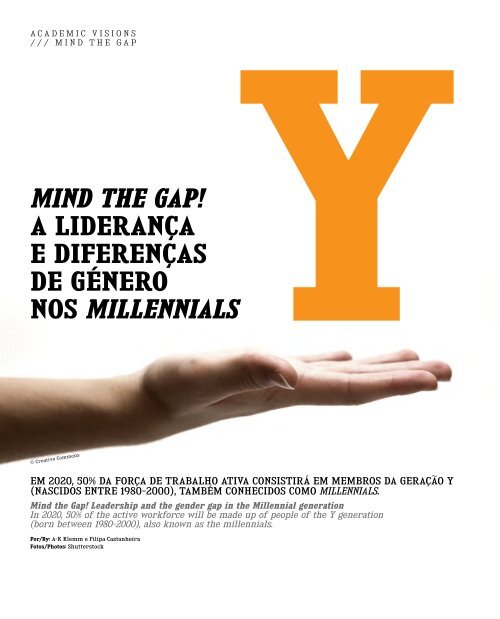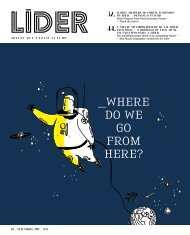Revista Líder – Setembro(2017) Nº1 Pago
You also want an ePaper? Increase the reach of your titles
YUMPU automatically turns print PDFs into web optimized ePapers that Google loves.
Academic visions<br />
/// MIND THE GAP<br />
Mind the Gap!<br />
A Liderança<br />
e diferenças<br />
de género<br />
nos Millennials<br />
© Creative Commons<br />
Em 2020, 50% da força de trabalho ativa consistirá em membros da geração Y<br />
(nascidos entre 1980-2000), também conhecidos como millennials.<br />
Mind the Gap! Leadership and the gender gap in the Millennial generation<br />
In 2020, 50% of the active workforce will be made up of people of the Y generation<br />
(born between 1980-2000), also known as the millennials.<br />
Por/By: A-K Klemm e Filipa Castanheira<br />
Fotos/Photos: Shutterstock<br />
A liderança e os Millennials: A tradição ainda é o que era?<br />
No que respeita aos papéis tradicionais de género, a investigação<br />
tem demonstrado que na geração dos millennials, pelo menos<br />
ao olhar para o mundo ocidental, a diferença entre os papéis<br />
feminino e masculino parece diminuir fortemente.<br />
Os millennials parecem ter crescido com a noção de uma<br />
certa igualdade de géneros, abertura à diversidade e aceitação<br />
da diferença (Burkhart, 2016). A questão que se coloca é saber<br />
como reagirão à medida que forem ingressando no mundo<br />
do trabalho e forem confrontados com uma nova realidade:<br />
O atual mercado de trabalho, ainda dominado por gerações mais<br />
velhas, tem bem demarcado os diferentes papéis de género<br />
(Eagley, 2003; Ericson, 2010), sendo as funções de liderança<br />
predominantemente masculinas (Frankel, 2014).<br />
Este estudo pretendia verificar se, entre millennials recém-<br />
-formados e ingressados no mercado de trabalho, persistia<br />
a diferença de géneros na liderança ou se, pelo contrário,<br />
se podia considerar que nesta geração se observava uma<br />
diminuição deste hiato. Com uma amostra de 127 participantes<br />
verificou-se não existirem diferenças significativas entre<br />
género em termos de educação, qualificação e número de<br />
línguas faladas. O que parecia um resultado promissor para<br />
o esbatimento das diferenças entre géneros começou, porém,<br />
a atenuar-se: Os resultados revelaram que, enquanto ambos<br />
os grupos se sentem igualmente preparados para assumir uma<br />
posição de liderança após a graduação, eles preferem diferentes<br />
estilos de liderança e tencionam liderar de forma diferente.<br />
A maioria das mulheres referiu sentir-se melhor preparada<br />
nos “conhecimentos académicos, capacidades intelectuais e<br />
competências específicas da formação”, ao passo que os homens<br />
referiram como principais forças as suas “competências<br />
analíticas, o conhecimento de IT e da tecnologia, bem como<br />
o conhecimento geral do negócio e experiência do trabalho”.<br />
As diferenças entre géneros começaram a ganhar mais<br />
preponderância (e a aproximar-se mais dos papéis tradicionais<br />
de género), quando questionados sobre os principais atributos<br />
de um líder: As mulheres selecionaram atributos típicos<br />
de liderança mais relacional, tais como “competências<br />
interpessoais” ou “comunicação eficaz”, ao passo que os homens<br />
privilegiaram atributos como “pensamento estratégico” ou a<br />
“ação corretiva e o controlo”. Quando questionados sobre até<br />
onde pretendiam evoluir na sua carreira, embora as mulheres<br />
e os homens pretendam assumir posições de liderança, a<br />
aspiração das mulheres em alcançar uma posição executiva<br />
superior foi muito menor que a dos homens. A maioria das<br />
mulheres 68,5% aspirava a uma posição de líder, mas “não ser<br />
o número 1”. Em contraste, 74,1% dos homens desejavam uma<br />
posição de topo na sua carreira.<br />
Leadership and the Millennials:<br />
Is tradition still what it used to be?<br />
Concerning traditional gender roles, research suggests that in the<br />
Millennial generation, at least in the western world, the gap between men<br />
and women has narrowed significantly. The millennials seem to have<br />
grown up with the idea of some gender equality, openness to diversity<br />
and acceptance of difference (Burkhart, 2016). The question is how they<br />
will react as they enter the world of work and are faced with a new<br />
reality. The job market, currently still dominated by the older generation,<br />
clearly distinguishes between different gender roles (Eagley, 2003;<br />
Ericson, 2010), being leadership functions still predominantly occupied by<br />
men (Frankel, 2014).<br />
The study envisaged assessing whether, among newly graduated<br />
millennials who had recently entered the job market, the gender gap in<br />
leadership prevailed or, on the contrary, if in this generation the gap<br />
had reduced. Based on a sample of 127 participants, no significant gender<br />
differences were found in education, qualifications and the number of<br />
languages spoken. However, what appeared to be a promising result in<br />
terms of decreasing differences between the two sexes, began to fade: the<br />
findings highlighted that, while both groups feel equally prepared to hold<br />
leadership positions after graduation, they show preference for different<br />
leadership styles and intend to lead differently. Most women said they<br />
felt better prepared with regards to “academic knowledge, intellectual<br />
capacities and specific training skills”, whereas men referred as their<br />
main strengths “analytical skills, IT and technological knowledge, overall<br />
business knowledge and work experience”.<br />
Gender differences became more relevant (and approached traditional<br />
gender roles), when asked about the principal attributes of a leader:<br />
The women chose the typical attributes of more relational leadership,<br />
like “interpersonal skills” or “efficient communication”, while the men<br />
preferred features like “strategic thinking” or “corrective action and<br />
control”. When asked how high they intended to go in their career,<br />
although both sexes intend to hold leadership positions, women aspire<br />
less to achieve executive offices when compared to men. The majority<br />
of women (68.5%) hoped to attain a leadership position, but “not to be<br />
number 1”. By contrast, 74.1% of men wanted to reach the top of their<br />
career.<br />
LIDER ideias que fazem futuro /85



